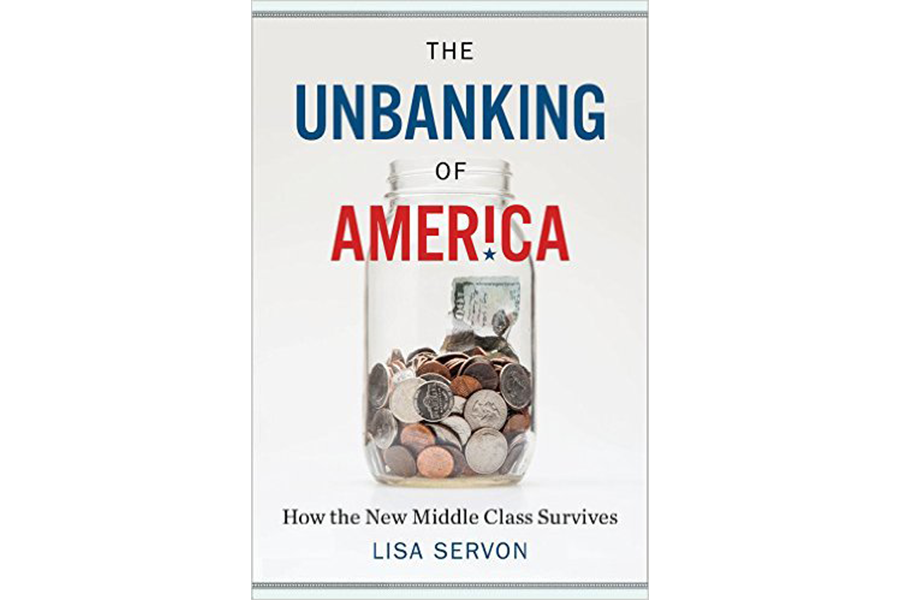'The Unbanking of America' asks why banks no longer serve the middle class
Loading...
Years ago I opened an account at a moderate-sized city bank. I was happy with them. But soon, they were swallowed by a much larger bank, which in turn was gobbled up by really big bank. Finally, this really big bank was devoured by a gigantic multinational bank.
Services suffered, fees increased, and account details kept getting more complex. Whenever I visit a bank branch and there are tasty pastries and other special goodies set out on little tables, I panic out of concern there’s been another acquisition.
It’s this phenomenon – banks getting much bigger, but much less helpful, especially for people of modest means – that Lisa Servon discusses in her excellent book The Unbanking of America: How the New Middle Class Survives. Ms. Servon points out that many people today don’t use banks; instead, they rely on check casher services, payday lenders, and other less-than-ideal alternatives.
“[M]any Americans have had it with banks. And the banks don’t seem to care,” says Servon.“Over the past four decades, most particularly since the financial crises of 2008, banking ... has morphed into a system that no longer serves the needs of far too many Americans.”
Commendably, Servon dives deep for her information. She goes to work for a check-cashing company, then later for a payday lender, to understand firsthand why people use businesses many consider dodgy and exploitive.
She provides a vibrant description of the thoroughly edgy, often dangerous, South Bronx, where she serves as a cashier. She befriends her primarily Latino customers and co-workers, and learns about their lives. She comments that “Almost three-quarters of Bronx residents have no money left over after paying the bills....”
So how, conceivably, can these money businesses suitably replace full-service banks? The answer is, they can’t. Servon convincingly argues that “In our modern capitalist system, no one can be financially healthy without reliable financial services that enable a person to save, spend, borrow, and plan.”
One big issue is fees, particularly overdraft fees, which many banks use to bulk up profits. Some banks engage in nasty practices such as “debit resequencing.” They use software to maximize overdraft fees by taking out larger withdrawals first, and not smaller withdrawals for which initially there would be sufficient funds.
By contrast, check-casher fees and interest charges by payday lenders are high – but straightforward. And for individuals who can’t wait several days for a check to clear, it is far better to pay a $10 fee then to allow the kids to go hungry. Meanwhile, many people in poorer neighborhoods don’t have easy access to a bank branch – or there are insurmountable obstacles to opening an account because of their low income and weak credit score. So there is no alternative to paying high interest to borrow money.
Servon’s compassion and intelligence light up every page of this valuable book. “Unbanking” exposes core reasons why many Americans aren’t gaining financial traction as she skewers huge banks for maneuvers and manipulations that have little to do with providing service.
But there are answers. At length, Servon profiles low-tech ROSCAs – rotating savings and credit associations also known as tandas. These informal “under the radar” operations – often managed by trusted community members – provide services to the “unbanked.”
Meanwhile, for tech-savvy millennials, and others who have no allegiance to traditional banks, mobile banks – banking services designed for use with smartphones, in partnership with pre-existing ATM systems – work well.
One promising advancement is Ripple – a firm dedicated to developing a system where “money and property can be transferred globally, in real time, for free.” Gone, for example, would be long waits for checks to clear.
“There is no shortage of promising ideas,” Servon says, before making her own thoughtful suggestions.These include “renew[ing] government involvement in the consumer financial-services sector,” providing access to clearer information about financial services, and creating a services rating system for financial institutions.
Nonetheless, she laments that even if these were implemented, “financial health will still be out of reach for [many] Americans [because they] do not have enough money.” They don’t earn enough for their labor, they don’t have access to “stable housing and affordable health care,” and they suffer “decades of indebtedness [resulting from investing] in their own education....”
She concludes her book by declaring “We need to demand financial justice.”
Many will disagree with some of Servon’s assertions. But there is no arguing with her central premise that many lower- and even middle-class people are poorly served by major financial institutions, and are suffering as a result.






